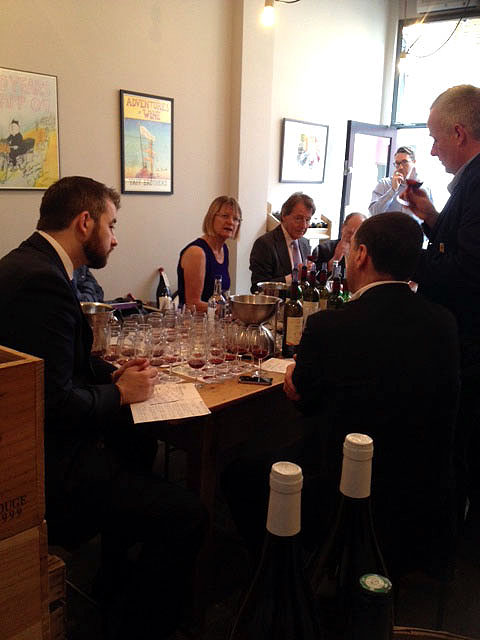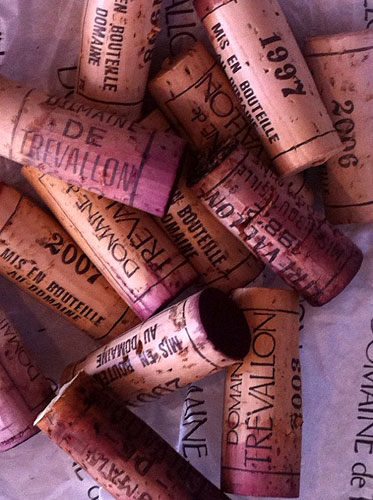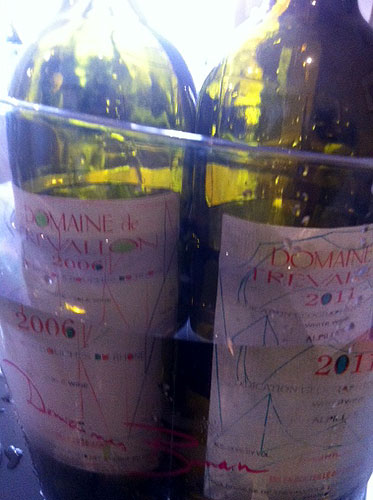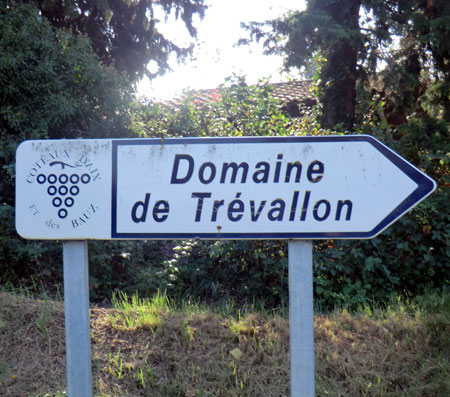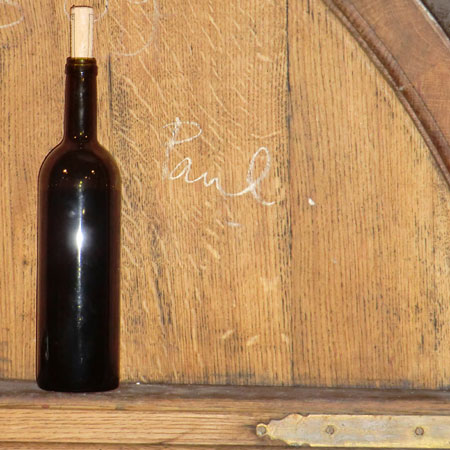To Otto’s Restaurant at number 182 on the Gray’s Inn Road last night to sample a dazzling vertical of Domaine de Trévallon accompanied by a decadent menu of specially selected dishes. The eponymous Otto and I go way back to the days when he was buying wine for a grand fin de siècle restaurant called the Auberge de Provence back in the 1990s.
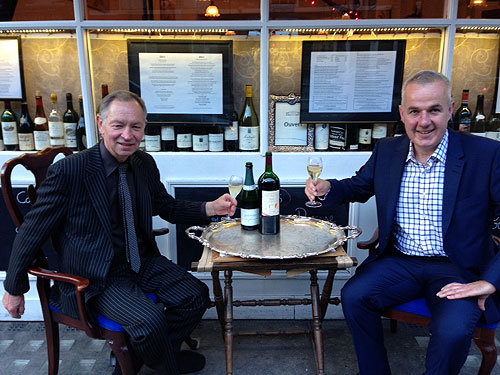
Otto Tepasse and Jason Yapp
As a young man Otto cut his teeth at La Tour d’Argent in Paris where he learned the arcane intricacies of the duck press and became a master of food and wine matching - skills which serve him well to this day. The wine list at Otto’s is lovingly curated and very reasonably-priced so unsurprisingly the restaurant is a default destination for gastronomically inclined oenophiles. To reward the party faithful Otto arranges periodical wine dinners when venerable vintages are broached alongside specially selected dishes.
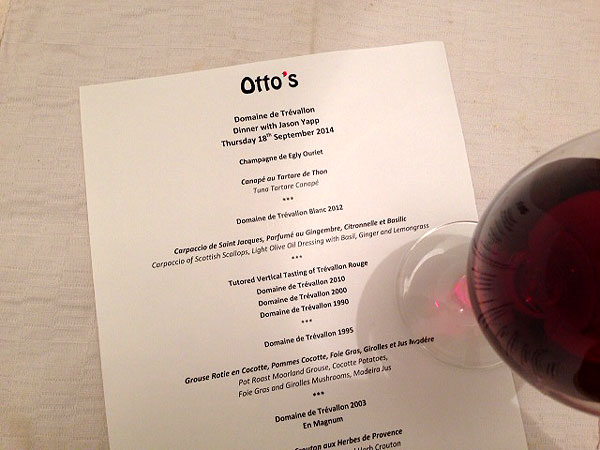
If a job is worth doing it worth doing well so Otto and I pulled out all the stops to produce a selection of wines and dishes that I very much doubt will ever be emulated. I had no idea what to serve as an aperitif so deferred to the creator of Domaine de Trévallon, Eloi Dürrbach, who staunchly recommended Egly Ouriet ‘Vignes de Vrigny’ Champagne. This is a lovely, fruity, citrus-edged wine made from pure Pinot Meunier on a family-run estate just to the west of Reims and I commend it to you. It set the stage nicely along with some tiny toasts of tuna tartare.
Once guests were seated we sampled the recently-released Domaine de Trévallon Blanc 2012 – a heady blend of 45% Marsanne, 45% Roussanne and 10% Chardonnay. It went down very well with a scallop carpaccio served with a basil, ginger and lemongrass dressing. In common with much white Rhône and Burgundy I expect that it is a wine that will age gracefully but it is drinking very well on its youthful fruit.
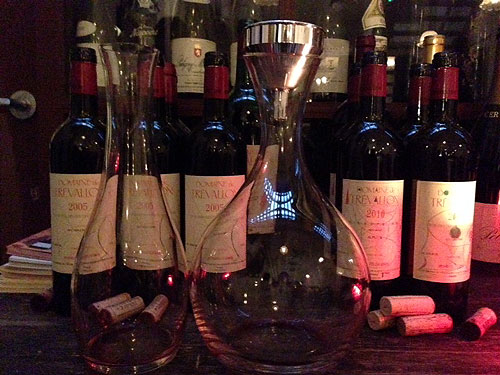
We then indulged in a flight of four vintages of red Trévallon. The 2010 – which is drinking amazingly-well for such a young wine and has very pure fruit and a fresh acidity. The 2000, which coming towards its prime but has plenty still to offer. The glorious 1990, which is fully mature, sensuous, rounded sweet and cedary and the impossible to source, touch-stone 1982 – a wine we sipped with reverence as there is none left in the Dürrbach cellars.
We then enjoyed a dish of casseroled grouse with foie gras and girolles along with a pairing of the 1995 and 2005 vintages. These two wines are not dissimilar in disposition but clearly demonstrate the benefits of bottle age as the 1995s rugged tannins have softened and yielded to a core of Autumnal dark fruit whilst the 2005 still has a degree of austerity and unyielding reserve.
We then tucked in to magnums from the sun-drenched 2003 vintage, that exudes warmth and southern spice, and went down a treat with some baked Saint-Marcellin.
To round off proceedings we were served an unimpeachable pear and almond tart accompanied by the ever-reliable Domaine de Durban: Muscat de Beaumes de Venise in the 2010 vintage that was chosen for its relative geographical proximity to Les Alpilles and its failsafe, crowd-pleasing qualities.
Everyone departed sated with a deeper insight into one of France’s most intriguing estates.
With thanks to Victoria Moore, Andrea Fasan, the ridiculously well-informed David Beresford , the Yap family (no relation) and the team at Otto’s for a highly-entertaining soirée.
At the end of last year after a whistle-stop trip down the Rhône sampling the promising 2012 vintage Jason Yapp took the opportunity to catch up with Antoine Dürrbach in the stunning new winery at his family's celebrated Domaine de Trévallon in Provence.
The 2012 vintage looks to be 'bien classique' with all the components to age well and provide many years of rewarding drinking.
Back in July, at our pop-up shop in Exmouth Market, Jason hosted a tutored vertical tasting of the thrilling wines of Domaine de Trévallon, Eloi Durrbach’s world-famous domaine with wines dating back to the early Eighties. (Jason's review of that tasting can be found on our blog here).
Jancis Robinson has recently written a review of that tasting and the Domaine too, which she has kindly allowed us to re-publish below. The original can be found on Jancis' website here:
http://www.jancisrobinson.com/tasting_articles/ta201308301.html
Jancis Robinson:
Last July a small group of us were treated to 'the second most comprehensive vertical tasting of Trévallon ever,' as UK importer Jason Yapp put it. The biggest collection of vintages of wine from this very particular property in the beautiful and hauntingly rocky countryside round Les Baux de Provence had taken place appropriately enough at the great Rhône wine lovers' meeting place of La Beaugravière in Mondragon in 2007.
Eloi Durrbach, giving up his architectural studies in Paris, planted 3 ha of vines in 1973 at St-Etienne du Grès at 50-100 m elevation on a property that had been the family holiday home since 1955. His parents had been celebrated artists and friends of Picasso. His mother was commissioned, for example, to make a tapestry of his acclaimed Guernica. According to Jason, the sale of this tapestry to Nelson Rockefeller underwrote Domaine de Trévallon to a substantial extent. The Cubist label used from 1996 onwards was designed by Durrbach Père. Eloi apparently did a deal round the kitchen table with his siblings to acquire the family property, no one realising quite how valuable it would become. He was allegedly retrospectively sued for a seven-figure sum, which resulted in a price increase, but there was a time when Trévallon was one of France's great wine bargains. (Today the current vintage of the red, 2009, sells for about £40 a bottle. Yapp are also currently offering the 2005, 1998, 1997 and 1984.)
The vineyards, heavily influenced by the limestone of Les Baux (which gives its name to bauxite incidentally) are north facing and planted with equal portions of Cabernet Sauvignon and Syrah - much to the displeasure of the INAO authorities whose official position was to sanction Grenache in this corner of France. Durrbach however was much influenced by Brunet who came from Ch La Lagune in Bordeaux to found Vignelaure outside Aix-en-Provence. Brunet was impressed by Guyot who promoted Cabernet/Syrah blends in Provence. Durrbach's Cabernet came from Bordeaux via Vignelaure and the Syrah from Château Rayas in Châteauneuf.
Yields have always been notably low in this dry, organically cultivated corner of the world - often as little as 25 hl/ha at Trévallon, producing between 600 and 700 cases a year, so old vintages are extremely rare. Even at the property itself they don't have a single bottle of 1982. François Perrin had to supply the bottle of 1982 for the Mondragon vertical.
The wines we were treated to at Medcalf in Exmouth Market, London, had made two journeys in their often long life: from Trévallon to Yapp Bros in Mere, Wiltshire, and then to London. Yapp explaing that he was sparing us 'the not-so-good vintages such as 1997'.
The first bottling was in 1976 but the breakthrough vintage was 1982. Robert Parker described it as 'one of greatest discoveries of my career' even if he fell out of love with it in the 1990s. On being told this, my fellow taster Steven Spurrier pointed out that he had bought the 1977 for his Parisian wine shop Caves de la Madeleine. This was the vintage, the second ever, that Jason's father Robin, founder of Yapp Bros in 1969, was given by a customer. Although it was inky black and quite unlike anything else he had ever tasted, he took a punt on it and never regretted it.
The grapes aren't destemmed at all and are fermented in open foudres with minimal sulphur additions - natural before their time? Fermentations can be dangerously hot so the wines tend to vary considerably from year to year. The young wine is racked into 300-litre tonneaux and aged for two years (reds) and one year (whites, with no bâtonnage).
As you can see from the many different appellations below, Trévallon is not exactly conformist. The AOC Les Baux was created in 2003, for example, but Trévallon was left out because it contains more than the specified maximum of 20% of Cabernet Sauvignon.
The vineyard now totals 19 ha of vines, of which two have been dedicated to a Marsanne/Roussanne white wine since 1991, to which was added about 10% Chardonnay from 1998. The oak on the whites has been less and less evident with time, fortunately. Perhaps unsurprisingly given its history, the wine varies enormously with the year. In 2002 floods were so bad that none was made. And the reds tend to become increasingly sweet with age, particularly the early vintages, but they all start off being particularly clean with a fresh finish - perhaps thanks to the height of the vineyards, even if the flavours themselves vary.
The wines are listed in the order tasted.
Dom de Trevallon 2011 IGP Alpilles 16.5 Drink 2012-2014
Deep straw. Great provençal twist - some herbs, body and ripeness though not remotely flabby. Racy and a tad hot on the end. Really interesting. The Marsanne really kicking in. Lightly honeyed and herby. A little like a good white Châteauneuf. 13.5%
Dom de Trevallon 2006 Vin de Pays des Bouches-du-Rhône 14.5 Drink 2008-2010
Deep straw. Much less aromatic than the 2011 - I miss the scent. Seems a little fruitless. 13%
Dom de Trevallon 2009 IGP Alpilles 17- Drink 2015-2023
Bright ruby. Well-melded nose with perhaps just a hint of brett? Some balsamic notes. Lots of Cabernet tannin - really very youthful and almost severe on the finish but with lots of ripe fruit in the middle. A tough baby for now. But it really opened out after 45 minutes in the glass. 13%. £39
Dom de Trevallon 2007 Vin de Pays des Bouches-du-Rhône 17.5 Drink 2013-2025
Dark crimson. Strongly herbally scented. Almost eucalyptus-like. But with masses of flesh. Clean and fresh on the finish. One of the more intense vintages. Great balance and drive. 14%
Dom de Trevallon 2005 Vin de Pays des Bouches-du-Rhône 17 Drink 2017-2027
Mid crimson. Mid intensity of nose. Quite brutal and bone dry, without the lusciousness of the 2007. Very dry finish. Uncompromising. Surly at the moment but it's tucked in there for the long haul. 13%. £47.50
Dom de Trevallon 2003 Vin de Pays des Bouches-du-Rhône 16 Drink 2013-2018
Dark ruby with some evolution at the rim. A little monotone on the nose, so to speak. As though the grapes were pretty desiccated. Very drying tannins on the end. Not much fun and I think it will never really have enough juice or charm. 13%
Dom de Trevallon 2001 Vin de Pays des Bouches-du-Rhône 18 Drink 2010-2020
Already a bit of development on the rim. Dark ruby. Very complex and developed aromatically. Balsamic note again (like the 2009). Tapenade (is this autosuggestion?). High toned. Much mellower than most vintages. Definite candied black-olive notes on the finish. Some richness before a firm finish. Already drinking well. 14%
Dom de Trevallon 1998 Vin de Pays des Bouches-du-Rhône 17 Drink 2007-2017
Bright ruby. Very interesting gamey/animal notes on the nose. Lively and punchy. Not very dense nor very ripe but full of character and definitely provençal. A little bit of herby dust but much juicier than the 2003. Long. A tad dry on the end. 12.5%
Dom de Trevallon 1997 Vin de Pays des Bouches-du-Rhône 16 Drink 2009-2017
Pale red. Stinky. Not quite enough fruit and it seems to have aged pretty fast. It's certainly proper wine but is not very fruity or appealing. 12%
Dom de Trevallon 1995 Vin de Pays des Bouches-du-Rhône 17- Drink 2002-2015
Fine bright subtle mid ruby. Heady and bright. Rather refreshing. Lively and a little animal. A tad austere on the finish. 13%.
Dom de Trevallon 1990 Coteaux d'Aix en Provence 17.5 Drink 2000-2018
Just 600-700 cases made. Light to mid ruby. Strong redcurrant aromas. Sweet, ripe palate entry and then the tannins have magically melted to leave quite marked acidity and a certain herbal dust. Lots of ripe fruit and charm though very definitely a food wine! 12.7%
Dom de Trevallon 1985 Coteaux d'Aix en Provence 18 Drink 1995-2015
Bright pale ruby. Light nose and the first one to be definitively of an older wine. Sweet and round and jewelly. Actually not unlike a slightly less alcoholic old Châteauneuf! Very clean and fresh. Lovely stuff.
Dom de Trevallon 1982 Coteaux-des-Baux-de-Provence 18.5 Drink 1995-2018
VDQS. So rare it has no commercial value. Quite a brownish tinge to the rust red. This is a famously rare wine. Old and dusty but not without charm by any means. Lovely sweet, very old, almost old Musar-like, or old Algerian-like. Masses of pleasure! Tinge of rose petals. Again, that clean, fresh finish. Long and very charming. On the way down but gives enormous pleasure.
One of the highlights of our 6 day ‘Pop-Up’ residency at number 38 Exmouth Market last week was a vertical tasting of 10 different vintages of Provence’s celebrated Domaine de Trévallon. The vineyard, which lies on the northern edge of the Alpilles massif, 25 kilometres south of Avignon, was first planted in 1973 by visionary vigneron Eloi Dürrbach who dropped out of architecture studies at Les Baux Arts in Paris to pursue his dream.
From the outset young M. Dürrbach caused displeasure amongst the chemises blanches (to use the derogatory vernacular for bureaucrats) at the Insitut National des Appellations d’Origine by eschewing the officially sanctioned Grenache and Carignan grape varieties in favour of Cabernet Sauvignon and Syrah in approximately equal volumes. As a result the estate has endured almost 40 years of topsy-tury classification starting out as a ‘VDQS Coteaux des Baux en Provence’ in the inaugural 1976 vintage, then becoming an ‘AOC Coteaux d’Aix en Provence – Les Baux’ in 1985 only to be demoted to being a ‘Vin de Pays des Bouche de Rhône’ in 1995 and finally becoming an ‘IGP Les Alpilles’ in 2009. No matter, the official nomenclature may be disastrous but the wine-making has been excellent. Eloi has farmed the estate organically from the outset and has a non-interventionist philosophy, only deploying natural yeasts and allowing the red wine to have a long (up to 2 year) élevage prior to bottling to allow for micro-oxygenation.
Eloi avers that too much manipulation in the cellar results in bland, homogenised wines that lack character. Consequently the wines of Domaine de Trévallon exhibit more vintage variation than many others which may explain the high level of professional interest in sampling a flight of 10 wines. Today the estate boasts 19 hectares under vine (two of which are planted with white grapes - Marsanne, Roussanne and a spot of Chardonnay) but back in the 1970s there were only 3 hectares in total producing around 600 cases of wine per year. For this reason older vintages of Trévallon are exceedingly rare but fortunately my father Robin took a gamble on a gut feeling about an ‘impenetrably inky and inert’ speculative sample of the 1977 vintage and we have shipped a relatively generous allocation ever since.
In the spirit of the ‘Pop-Up’ I wanted to make the tasting relatively manageable and upbeat but narrowing the race-card to just 10 vintages of red and 2 of white was not easy. In the end the whites were pretty much self-selecting being the only 2 years we had several bottles of - 2011 and 2005. For the reds I chose personal favourites and wines from failsafe vintages with accredited historical testimonial – 2009, 2007, 2005, 2003, 2001, 1998, 1995, 1990, 1985 and 1982. I had tasted the 1990 last month at Andrew Edmunds restaurant in Soho and it was a shoe-in. I’ve never had a dud bottle and it’s always been delightful. The legendary 1982, once described by Robert Parker as being ‘stunning’ with an ‘explosive richness’ was another obvious choice not least because the Dürrbachs themselves no longer have any library stock. I also bought along a bottle of the 1997, a lighter vintage I’ve never much cared for as an optional extra for those who wished to try it.
A combination of rare wines and a small venue meant we had no problem gathering a posse of professional tasters to sample the line-up including journalists (Jancis Robinson, Victoria Moore, Matthew Jukes and Stephen Spurrier) restaurateurs (Andrew Edmunds and our host at number 38 Simon Lee) sommeliers (François Bertrand, Andrea Fasan and Laure Patry) and our old friend Stephen Browett the boss of fine wine traders Farr Vinters – a longstanding Trévallon fan.
Happily every single wine we opened was in good condition – perhaps a reflection of the fact that they had all stayed in our cellars since shipping. The highest scoring wine on the day was the fully mature red ’82 followed by the 1990 which still has amazing vigour. The 2007 was the best youthful vintage – already eminently drinkable with lovely a concentration of ripe, dark fruit and the 2001 vintage indicated that it can drink very well in middle age. So much so that we revisited a second bottle over an unimpeachable lunch next door in Medcalf. Of the two white wines all but two of us preferred the 2011 but both were showing well and very pleasant to drink – somewhat academic given its scarcity.
The post-tasting round table discussion concluded that Domaine de Trévallon is a wine of great vintage variation but also of longevity and character. I still can’t improve on Clive Coates’ description from a 2000 edition of ‘The Vine’: “How do you describe the wine? Splendidly coloured. Impressively concentrated. Structured without being brutally solid. Balanced and complex. Those are the bare bones. And the flavours? Blackberry and blackcurrant, cedary and almost sweet in its richness, with an aspect of roasted wild Provençal herbs. It is a wine of the garrigues; it is a wine of uncompromising personality; and, like its origins, it is a wine of no half measures. There is danger here. There is excitement. There is passion.”
A 3.00am start in London to catch the ‘commuter’ flight to Marseille is never a joy but the blue skies and Provençal sunshine off-set any fatigue. We hit the ground running and were tasting at Domaine de Trévallon by 11.00. Antoine and Ostiane Durrbach gave us a warm welcome and we were treated to a whistle-stop tasting of the 2010 from barrel and preceding vintages from bottle. The vintage run since 2007 has been superb and they were delighted to have harvested good volumes in 2011 in optimum conditions. We were amused when Antoine showed us a tonneau signed by Sir Paul McCartney on a recent visit, having just supplied the wines ourselves for his wedding party (via celebrated events company GLD productions, www.gldproductions.com).
We cracked on North to Vacqueyras for an extensive sampling of Rhodanienne wines chez Pascal Frères. Having explained our pressing agenda to the Chéron family in advance, they kindly provided a working lunch of coarse rabbit paté, pain rustique and a bountiful board of local cheeses. Thus fortified we spent a fruitful afternoon in glorious Châteauenuf-du-Pape visiting Domaine Père Caboche and Le Vieux Donjon, both of whom were proud to produce tub-thumping 2010s and have high hopes for the very recently harvested 2011s.
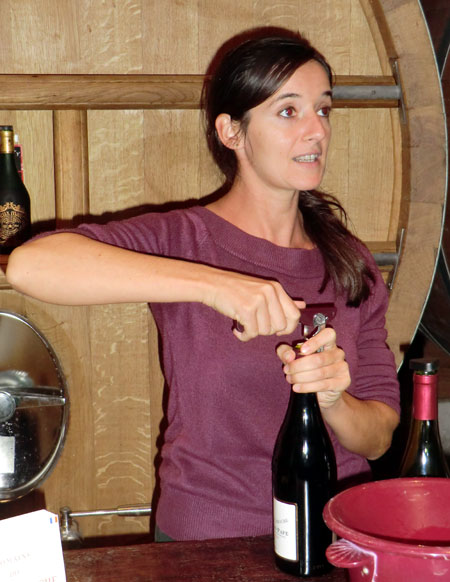
Emilie Boisson
Onwards and upwards as we head for the North tomorrow.

Claire Michel
A couple of years ago over a long and languorous lunch at Le Café Anglais, with chef-patron (and FT food guru) Rowley Leigh, I was lamenting the fact that while the cuisine of Provence is justifiably celebrated its best wines are regrettably overlooked. Rowley is a man of action who requires little encouragement and before I knew it ‘Le Grand Aïoli’ had been born. Rowley had devised a Provençal feast with aim of pairing some of the region’s top wines with classic Mediterranean dishes. The inaugural Grand Aïoli, in June 2010, was a hedonistic affair with a mouth-watering menu encompassing olives, sardines, seabass and beef brisket accompanied by lashings of Cassis and a budget-busting Domaine de Trévallon. All those who attended seemed to enjoy themselves enormously – there certainly weren’t any complaints – so, I guess, it was inevitable that sooner or later we would do it all over again.
The second (and, having since reviewed the margins, almost certainly final) Grand Aïoli took place last Thursday at Le Café Anglais and, I have to say, Rowley surpassed his previous efforts. Word was definitely out in London’s foodie fraternity that good things were afoot as seasoned truffle-hounds like Fergus Henderson, Bill Knot, Matthew Fort, Jeremy Lee and Tom Parker-Bowles could be seen priming their palates with a blameless, coral-pink Coteaux d’Aix: Domaine Oullières 2010 at the bar before we were under starters’ orders.
Glistening bowls of pungent, fresh Aïoli appeared as diners were seated and plates of salt cod, prawns, radishes, sweetbreads and artichokes soon followed. With this magnificent medley we served an organic Bandol Blanc: Mas de la Rouvière 2010, which is made from pure Clairette and has inimitable wild herb scents and flavours which married marvellously with the garlic-infused mayonnaise.
Next up came a Bourride of hake, Gurnard, monkish and John Dory that Rowley served in bowls en place and soon solicited sighs of gastronomic contentment. This piscine tour de force was accompanied by a rare Bellet Blanc 2010 from Domaine de la Source. Made from 100% Rolle this sapid, savoury, straw-coloured, niçeois white did nothing to assist an already straining budget but it did take the food and wine matching to new heights and amply illustrated that you get what you pay for.
A brace of bountiful reds was then brought into play to do justice to a stupendous ‘Grillade des Mariniers du Rhône’. The crowd-pleasing Côtes du Luberon 2009 from the ever-reliable Château la Canorgue stood up well to the culinary alchemy of very slowly-cooked skirt beef with onions and seasoning but the vinous high point was probably the celebrated (and horriblement cher) Château Simone from Palette. This majestic, antediluvian, anachronism is made from a blend of 17 different grape varieties including such rarities as Branforcas, Manosquin and Castels. It has the cassis, cedar and sandalwood characteristics of a venerable old Claret but a wild, untamed touch of the garrigues in the background too – no wonder Winston Churchill was a fan.
We rounded proceedings off with a divine apricot and almond tart alongside the peerless, orange blossom-scented Muscat de Beaumes de Venise 2007 from Domaine de Durban. Although the west London skies were overcast you could feel the warming sun of the Côte d’Azur in the dining room of Le Café Anglais. Who knows? If we can find a generous benefactor we may even do it again next year...
Fortified by a superb dinner at Guy Julien’s truffle-orientated restaurant ‘Le Beaugravière’ in Montdragon (which has a legendary Rhône wine list) we arrived in Châteauneuf-du-Pape on Wednesday morning greeted by a blue sky and southern sunshine.
At Le Vieux Donjon Marie-José Michel and her daughter Claire gave us a warm welcome and the happy news that the Rhône 2009 vintage had surpassed their expectations. We then sampled a bottle of their excellent white Châteauneuf’ 2009. Made from equal volumes of Clairette and Roussanne this mid-weight, un-oaked offering has subtle citrus and ‘fleurs blanches’ scents and a bright, palate of white orchard fruit underscored by a clean acidity. It is drinking wonderfully well right now and should continue to do so for a further 3 years. Claire then produced a cask sample of the red Le Vieux Donjon 2009 which exhibited a powerful bouquet of red fruit and a complex palate infused with garrigue berry and Provençal herb notes. We then compared with a bottle of the blockbuster 2007 vintage (which still has plenty of youthful vigour) and although the 2009 is a shade lighter and less concentrated (dare we say more feminine?) it is clearly a superb and age-worthy wine.
Down the road at Domaine du Père Caboche another young vigneronne, Emile Boisson, was equally upbeat about the 2009 vintage. The Boisson family is renowned for producing forward-drinking, fruit accentuated wines for immediate gratification. Their white Châteauneuf-du-Pape 2009 is a classic with a fresh, sapid palate and attractive white peach aromas. It is cleaner and zestier than most of its peers and you could happily drink it as an aperitif. The principal cuvée of red Châteauneuf’, called simply ‘Domaine du Père Caboche’, has a bright bouquet of crushed red berries and a supple, silky palate of warming red fruit flavours and ripe, sweet tannins. This is a wine for shameless hedonistic consumption while waiting for grander, more contemplative wines to mature. The Boissons’ flagship wine called ‘Elisabeth Chambellan’, from 100 year-old vines on ‘La Crau’ plateau, is deeper, darker, richer and more complex than the regular bottling but it retains the domaine’s signature of seductive, come-hither fruit. It will age well for a decade – if you’ve got the patience to wait that long.
Having completed our tastings in Châteauneuf’ we then headed south to Les Baux to sample the wines of Domaine de Trévallon. Strictly speaking this is in Provence and not the Rhône valley but it’s certainly a wine that appeals to Rhône enthusiasts so we were keen to pay a visit. After successfully negotiating the backwaters of Les Alpilles we were greeted by Antoine Dürrbach and his younger sister Ostiane who are both now firmly involved in the family business. We kicked-off with a tasting of the rare and idiosyncratic white Domaine de Trévallon 2009. Made from a unique blend of Marsanne (45%), Roussanne (45%), Chardonnay (7%) and Grenache Blanc (3%) raised in oak barrels (half of which are new) this is rich, powerful, gastronomic wine that probably requires a bit of bottle-age and a food accompaniment to be seen at its best. We then sampled the 2009 red Syrah from barrel which had an impressive purple colour and a core of concentrated sweet, black fruit over fine-grained tannins. We then tasted the Cabernet Sauvignon which had a lovely cassis bouquet, very bright fruit and a fresh acidity. The obvious thing to next was to sample a blend of the two together which produced a really harmonious result – a great balance of berry aromas, ripe fruit, sweet tannin and clean acidity. Considering its southern location Domaine de Trévallon is a very vintage sensitive wine and it appears that the 2009 is going to be a classic. As in Châteauneuf-du-Pape some of the raw power of the 2007’s might be missing but there is great balance and purity which will yield a wine of elegance and enormous future gratification.
After another day spent tasting young Rhône wines there is really only one choice of liquid refreshment – a cold demi pression or two in ‘Le Mistral’ bar in Orange.
Jason & Tom.






